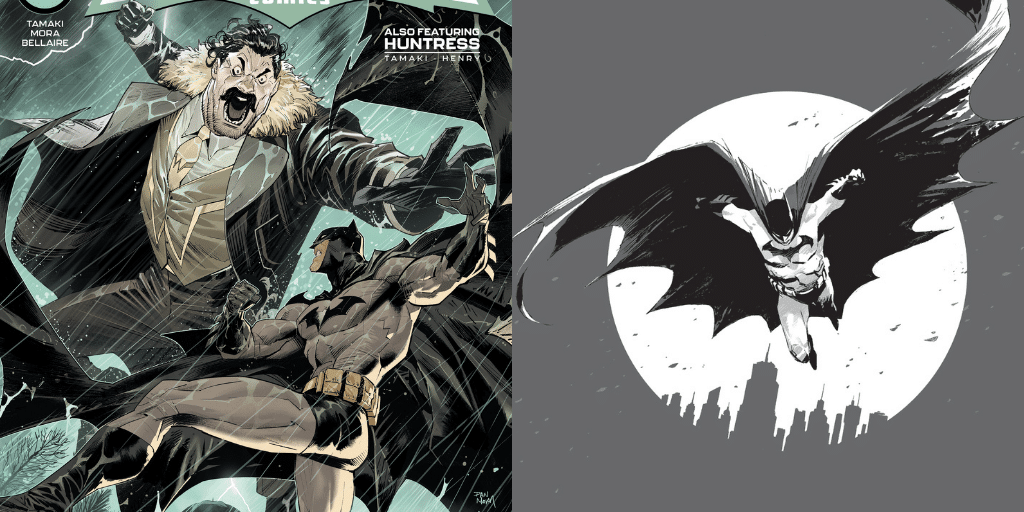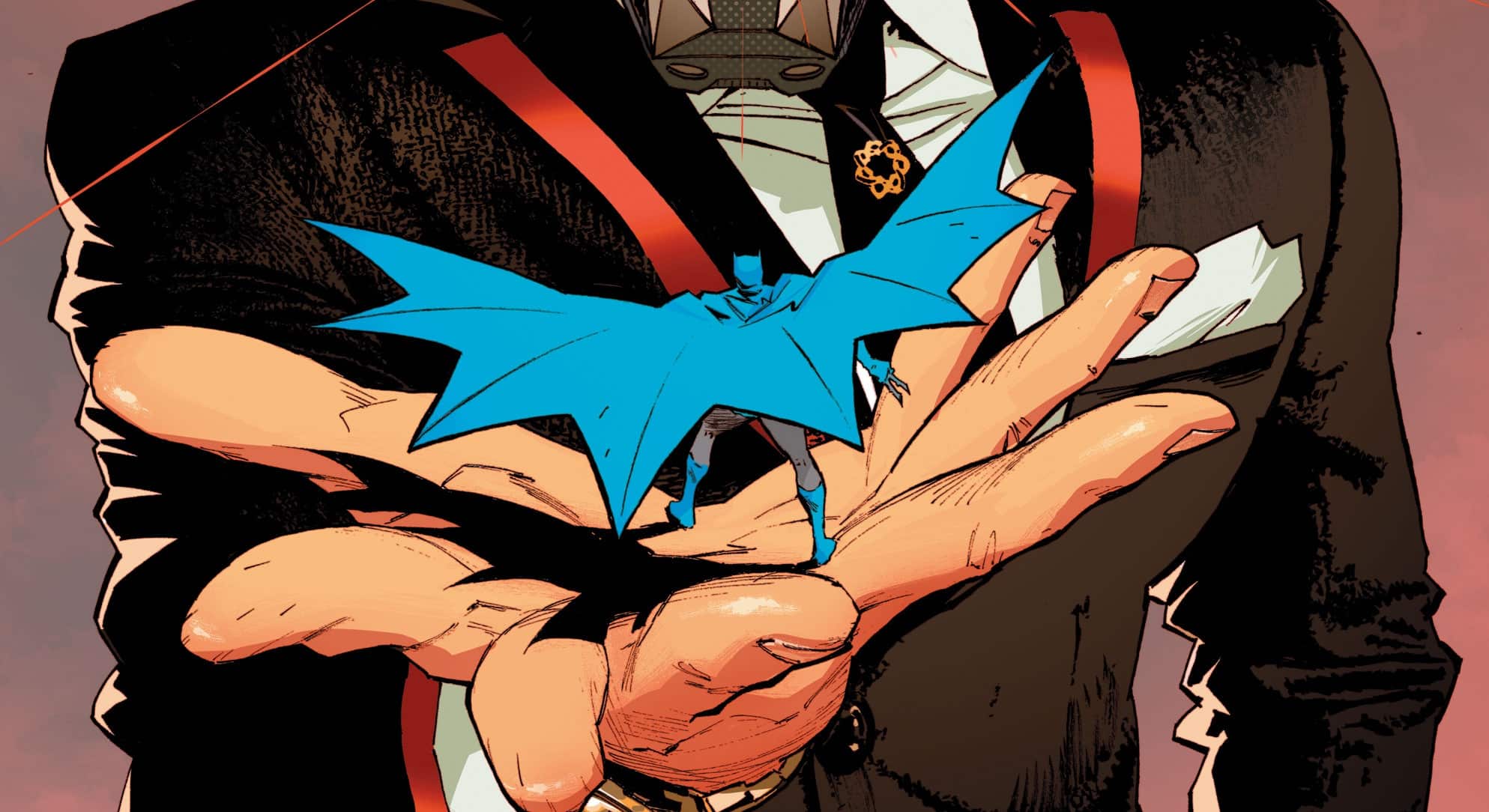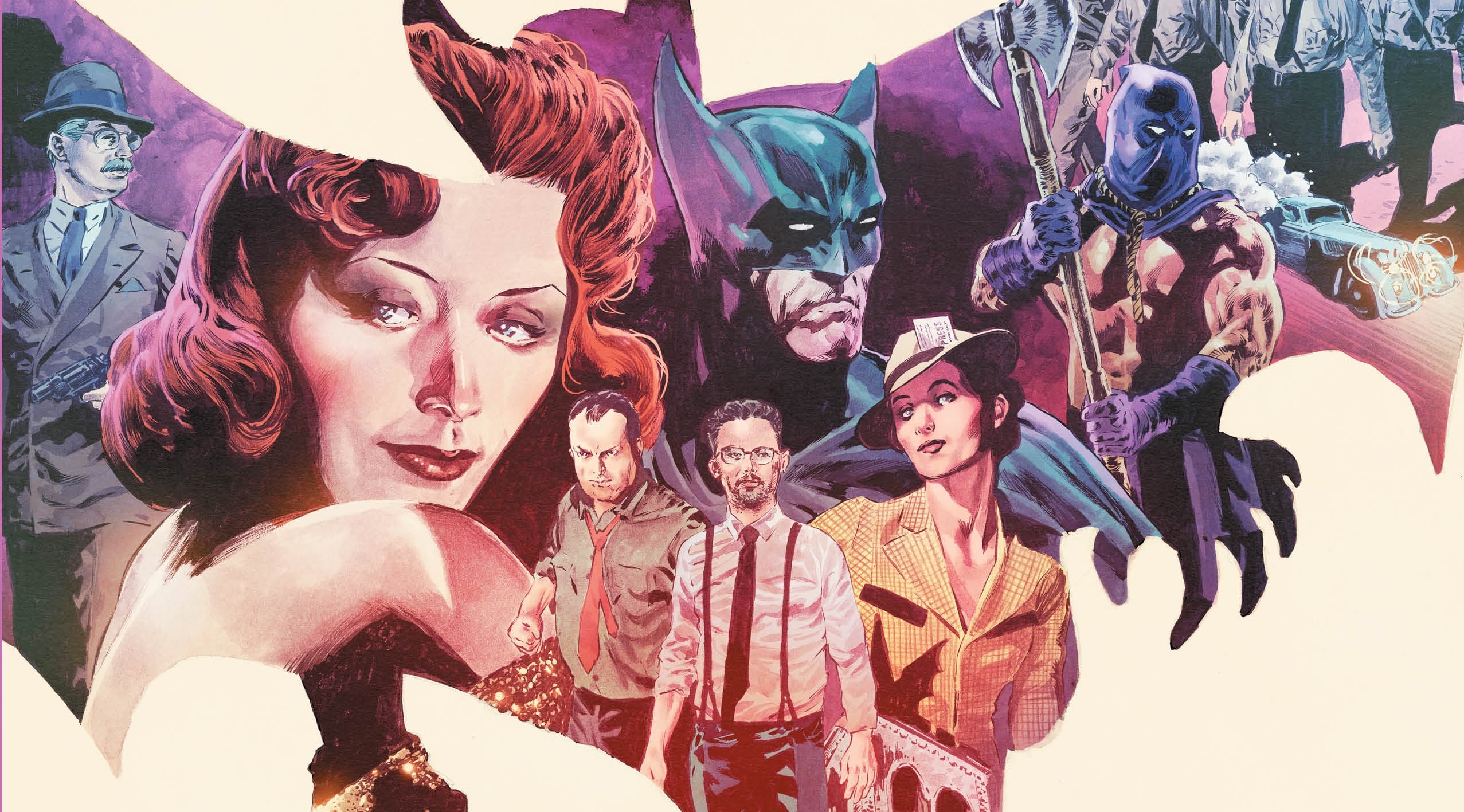Welcome back to Bat Chat with Matt (and Will!). In Detective Comics #1,035, the mystery of what is happening in Bruce Wayne’s new neighborhood of Fort Graves deepens, as death and mourning couple with corruption in a story written by Mariko Tamaki, drawn by Dan Mora, colored by Jordie Bellaire and lettered by Aditya Bidikar.
And in a Huntress backup story, Helena makes a civilian friend. But since Huntress is part of the Bat-family, this doesn’t end well, in a story written by Tamaki, drawn by Clayton Henry, colored by Bellaire and lettered by Bidikar.
Meanwhile, Batman: Black and White rolls on with issue #5, featuring:
“A Father and Son Outing,” written and drawn by Jorge Jimenez and lettered by Rob Leigh.
“Signals,” written and drawn by Lee Weeks and lettered by Clayton Cowles.
“Blue,” written by Tamaki, drawn by Emanuela Lupacchino, inked by Wade Von Grawbadger and lettered by Ariana Maher.
“The Riddle,” written by Kieron Gillen, drawn by Jamie McKelvie and lettered by Cowles.
And “The Man Who Flies,” written and drawn by Jamal Campbell and lettered by Deron Bennett.
Matt Lazorwitz: I’m a pretty happy camper this week. Detective remains the strongest title featuring Batman as the protagonist, doing a good job of balancing character and plot, even if the mystery isn’t the strongest, and I can think of very few issues of any iteration of Batman: Black and White that looked as overall stunning as this issue.
Will Nevin: Yeah, Brother Matt, this was not a Batman/White Knight/Why Am I Doing This To Myself week — your diagnosis of ’Tec is on point, and Black and White was a solid read. It’s nice to have not much to complain about.
Death and Rebirth in Fort Graves

ML: The main story in Detective Comics opens up not directly after the last issue but shortly on its heels, with Batman and the GCPD investigating the disappearance of one of Bruce Wayne’s new neighbors, Sarah Worth. I continue to be impressed with how Mariko Tamaki has Batman’s internal monologue down pat after having only written a handful of issues. The analysis he does as he starts going over evidence is clinical, but there’s still an empath underneath it, a concern for the victim, that is forgotten in lazier Batman writing, where he’s this detached, all too cold machine rather than someone who can recognize the pain of those he’s trying to protect.
WN: This is the good Batman writing right here, and with the inherently disjointed nature of Future State getting farther and farther behind us, I’m only able to appreciate Tamaki’s work more. Not only did she turn in a stellar Black and White story (which I’m sure we’ll talk about), but this is some of the best Batman work in months: This Batman is deliberative and thoughtful; the series has action without being senseless, frenetic motion. Characters have weight and substance. I am struggling to come up with a single beef with this issue, but aside from “Yeah, no one would order a crime scene to be covered in concrete,” I got nothin’.
ML: I love how she’s fleshing out her corner of Gotham. Her take on Mayor Nakano is much less supervillain leaning than I feel he is other places. I don’t think his temperament is right for mayor of a major city, but this Nakano is much more in line with the politician ready for the fall than the one waiting to don a crazy costume and go out and wreak havoc on Gotham, which I’m good with. Tamaki and artist Dan Mora created Nakano in Detective Comics #1,027, so if there’s anyone who would have a feel for him, it would be them.
WN: I think — and this is just my supposition here — at this point, we’re probably supposed to have sympathy for Nakano as a guy who’s totally in over his head. And that works as long as we see his staff — that damned Neil! — continue to orchestrate things that will eventually get us to the Magistrate. But the turn comes when he learns what’s happening and decides whether to stop it or press on.
ML: I’m wondering if Neil is the big bad here, or if it’s Hue, who is doing something to make Neil his catspaw. I thought last issue that Hue was Simon Saint, as they have a very similar look, but now I’m wondering if that isn’t just two artists working off a similar model, the tech guy, but might be coding tying them together.
I’m also opening myself up to a comment or two from our fellow staff here, but I’m curious to see more of Mr. Worth, who, yes, is a new character. He’s such an odd design, this hulking business man, and the rage he shows is logical and radiates from the panels he’s in.
WN: You know, I was looking forward to a Friday without Zoe and Cori in my mentions, but now you’ve gone and fuckin’ done it.
ML: Sorry, my man. I think we’ve driven our feeling about this home, but I have one more analogy I want to posit as to why this works and so many of the other new characters don’t. And I’ll make it quick. How familiar are you with The Simpsons? I’m talking, classic, first nine seasons of the show, not obscure Season 23 stuff.
WN: The cult classic that was canceled after nine seasons? I know the 30,000-foot highlights, but I’m not much help beyond that. But I can pretend for the benefit of a bit.
ML: OK, well there is an episode called “The Itchy & Scratchy & Poochie Show” where a dog is introduced into the Itchy & Scratchy cartoons the kids are always watching. He’s “extreme,” and while there’s all this excitement for him before he debuts, no one likes him, and ideas bandied about to improve him include, “When Poochie isn’t on screen, people should be asking, ‘Where’s Poochie?’” Mr. Worth and Bruce’s neighbors here feel like organic parts of a story, not characters who, every time they’re not on page, we feel like we need to be asking where they are. Organic character development, rather than characters who we’re meant to love from jump. And that’s it. That’s my final statement on this whole thing.
WN: One more question. Nakano — and maybe someone else? — asks specifically for the “chief of police” in this issue. And initially, that struck me as weird, but then I remembered my Batman ’66, which indeed featured both Commissioner Gordon and Chief O’Hara. What’s the current structure of the GCPD — is Montoya the commissioner and there’s a chief we’ve yet to meet? Or was this some sloppy dialogue?
ML: I think it’s the latter. Usually, and I had to look this up, police commissioners are either elected officials or serve above and outside the structure of police; they serve at the pleasure of the mayor. Chiefs are the highest-ranking non-political police position. Commissioners can just be fired, like the secretary of defense, while the chief is the chairman of the Joint Chiefs of Staff; he can be removed from that position, but he’s still an admiral or general. That’s oversimplifying something, but it seemed the closest answer I could get.
Before we move on, I just have to stress how much Mora does for this book. His action scene of Batman fleeing the GCPD in the sewers is beautiful; the action just flows seamlessly. His Bruce Wayne looks just rough enough that you understand he doesn’t have Alfred to watch out for him. The design on Mr. Worth is great, with his hulking presence and the W’s worked into his outfit. And that last page is horrific in all the best ways.
WN: That shit was tight. Reminded me of a gimmick we’ve seen a couple of times on WWE programming when Vince and co. flash the on-screen credits to make you think the show’s over. And then BOOM.
Huntress
ML: We got a brief appearance of Huntress in the main story this issue, before getting a nice little backup feature for her here. This doesn’t have the same weight as that opening story, but it’s a nice character piece. Again, Tamaki uses first-person narration to really dig into who Huntress is. It’s been a while since she was a featured player, so I’d wager this might be the first exposure some more recent readers have to her in the comics.
WN: The Punchline and Robin backups have got me trained to ignore them, and I almost did that here, but this was really worth the read. And while you said this doesn’t have the weight of the feature, I appreciated the tragic coda — and the setup for the next chapter: justice with a streak of vengeance.
ML: Oh, the ending is very well wrought. I like how Huntress draws parallels between herself and Mary, and she’s a character who understands vendetta, so that ending is intense. There’s just only so much oomph you can put behind a story after only eight pages. But there’s a cat, and I’m a sucker for a fluffy cat. I am very much looking forward to where this goes.
Clayton Henry does a solid job on this. He’s one of those artists who has been working for 20-plus years, and while he’s never been a superstar, when you need someone who can do good facial expressions, even under masks, and give you clean lines and solid storytelling, he’s definitely an artist to call.
WN: This has been the best Infinite Frontier backup we’ve read for Bat Chat, right? Like, I don’t think anything else is close.
ML: Hands down.
Batman: Black & White #5

WN: The race for top story is incredibly tight in this one — I thought “Signals,” “Blue” and “The Riddle” were all world-class shorts.
ML: Oh, no doubt. I love when comics play with a Choose Your Own Adventure format, so I’m an easy mark for “The Riddle.” Add Jamie McKelvie’s art, especially his take on Killer Croc, and it’s hard to pass up.
WN: “The Riddle” is a perfect place to start here. There was no way to honestly “win” that, right?
ML: Not an easy way.
WN: That implies there is a way. Am I just stupid?
ML: No. I just went back and double checked. There is no “Got to 39” which would be the win condition.
WN: *whew* Good. So it’s exactly what I thought it was: a perfect meta reference to Batman’s ability to always come out on top. We passed the Bat Kobayashi Maru, Matt!
ML: I love that reference.
“Blue” also hit a sweet spot for me, because it features Gilda Dent, Harvey’s oft-forgotten wife. Gilda is a character who appears most notably in The Long Halloween, and is remembered for an ending that is divisive to say the least, but this is a logical extension of what Gilda is there, and Emanuela Lupacchino does a gorgeous job on it. I would love to see Tamaki, who wrote this, bring Gilda back over into ’Tec at some point.
WN: I was going to ask you about Gilda’s history, but you already covered it. Nicely done. And since both this and the Huntress backup touch on domestic abuse, it seems like Tamaki has some things to say there — you might get your wish.
“Signals” was nothing really fancy, but it got to the core of Gordon’s character in only a few pages: deeply anti-corruption but also willing to forgive in the right circumstances.
ML: You know I’m a soft touch for a Jim Gordon story.
The other two stories follow up on something this series has been doing, which is giving artists their first chance to solo-write a story for DC. And while they weren’t as strong storywise as the other three, I think they’re better than a bunch of the other first-time writer/artist stories we’ve gotten in this run, and they were both visually striking.
WN: To me, the Jimenez piece felt like a lot of artists getting one of their first chances to script a story — too much talking, over-explaining, etc. But you’re right in that it sure looked pretty.
ML: Oh, no doubt, it was chatty. If it had shaved off 25% of the dialogue and captioning, I would have liked it more.
“The Man Who Flies” by Jamal Campbell was artistically maybe my favorite piece in this issue. I really liked Campbell’s work on Naomi, and I fell in love with it on Far Sector. He has a dynamism that suits Nightwing perfectly; when you’re drawing Dick Grayson, more than any other character in comics, you need that feeling of movement in three dimensions.
WN: The art? Dynamic as hell. The story? Not so much.
ML: It was a bit all over. I wish it had either focused on Dick on a case and shown how he was with the victims, or if it had just been Dick swinging through Gotham and reminiscing. Trying to do both in just eight pages was too much.
WN: Everyone loves a big, ol’ swingin’ Dick.
Bat-miscellany
- The cover for ’Tec, which features Mr. Worth and Batman engaged in fisticuffs, was a bit of false advertising.
- I really hope that Huntress keeps Doug the cat.







